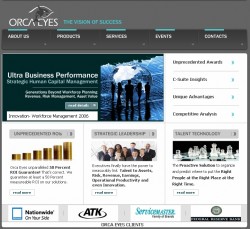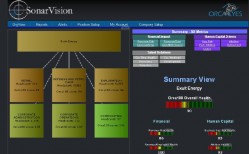 Recruiter of the year Dan Hilbert must have found the smartest 4th graders on the planet for his OrcaEyes focus group. He says that it took them no time at all to navigate through the OrcaEyes console, generating reports on the cost of vacancies in an Exult Energy division and on the financial impact of an 80 percent improvement in time to hire for that group.
Recruiter of the year Dan Hilbert must have found the smartest 4th graders on the planet for his OrcaEyes focus group. He says that it took them no time at all to navigate through the OrcaEyes console, generating reports on the cost of vacancies in an Exult Energy division and on the financial impact of an 80 percent improvement in time to hire for that group.
After taking a whirlwind tour through some of the things OrcaEyes can do, I have no hesitancy in admitting that “I’m not smarter than those 4th graders.”
Of course the significance of those reports was lost on the kids. Hilbert just wanted to make sure the navigation was easy to use and the red-yellow-green alert system easy to understand. And they are.
But it’s those reports that make the $200k a 20,000-employee firm can spend on OrcaEyes seem like a bargain.
Before I get into how, here’s a bit about the what, as in just what is OrcaEyes? Hilbert describes it as HR System Management Software. You can think of it as ERP for HR. Either way, the system provides an overarching view of how human capital impacts the enterprise. It does this by connecting to a company’s existing business systems — hooking into finance, sales, operations, supply chain, or an ERP (if there is one), the HRIS, HRMS, and whatever others may be there.
OrcaEyes crunches the data it extracts from these systems and combines it — for certain uses, like recruiting and salary setting — with data Hilbert obtains from such external sources as the U.S. Bureau of Labor Statistics, Census, and private data providers. Thus, in an instant, literally, an HR recruiter and a division VP can tell the cost in lost business for staffing shortages in the North Sea unit of Exult Energy’s refining and petrochemical division.
I thought that was nice information to have, but no special feat since any CFO can do revenue averages per year-end headcount. But as every CFO and line manager knows, being down one position doesn’t translate into a direct or immediate loss of revenue. Depending on the size of the unit, other workers will pick up the load.
 Here’s where the magic of OrcaEyes comes in. The system is too smart to simply say you’re in danger of losing $1 million in revenue just because that’s the average. Nope. It knows, because you’ve told it during the setup, that losing one worker for a short period will have a minimal impact. But as the number of vacancies increases and the vacancy time lengthens, the bigger the effect and more bars on the OrcaEyes report turn red.
Here’s where the magic of OrcaEyes comes in. The system is too smart to simply say you’re in danger of losing $1 million in revenue just because that’s the average. Nope. It knows, because you’ve told it during the setup, that losing one worker for a short period will have a minimal impact. But as the number of vacancies increases and the vacancy time lengthens, the bigger the effect and more bars on the OrcaEyes report turn red.
This is also a modeling program, not just a “what is” program. So OrcaEyes knows that besides the current vacancy, the attrition rate is such that there’s a high probability of losing more employees in the unit soon. And retirements will add a few more. Now OrcaEyes can tell you what the impact of all those things occurring — or some of them — will be.
That’s but one example of what this data-based analytics program can do. Even though OrcaEyes has only just recently come out of the incubator, there are plenty of other examples of its value from the 10 Fortune list companies that have been testing it now for several months.
I asked Hilbert for a sampler and here’s what he sent:
- A global manufacturing company discovered that when overtime for operators, maintenance, and skill trade workers exceeds 12.5 hours for three weeks, accidents increase by 105 percent. When the company added staffing to reduce the OT, the savings from fewer accidents came to $370 million in just two quarters;
- A retail company discovered there is a correlation between store clerk overtime and theft and customer complaints. When OT begins to exceed an average of 11.8 hours for three consecutive weeks, thefts increased by 41 percent and customer service complaints increased 52 percent. The retailer loses one customer for every 2.6 complaints.
- That a manager with poor ratings by their staff affects bottom line performance is not an “Aha” moment. But just how much? Hilbert tell us that a retailer found store sales revenue dropped by 1.2- 1.8 percent for each 10 points below a 75 percent manager approval rating.
OrcaEyes, says Hilbert, provides “just about every metric you can imagine.” And many you might not have thought of. Another example: Our mythical oil company Exult Energy needs chemical engineers. Where in the U.S. are prospects the best for finding engineers who are most likely to come to work for Exult? Would you believe Bay City, Michigan?
OrcaEyes was born out of Hilbert’s years with the much lauded Valero Energy. He was Global Planning and Talent Lead for the fast-growing oil company, landing the job with almost no direct HR experience, but a broad business knowledge from having CEO’d tech firms. During his four years at Valero Hilbert won award after award for his programs, including five from ERE alone.
It was during those years he came to appreciate the integration of HR and business purpose and metrics. In the process, he turned Valero into a poster child for data-driven recruitment. Dr. John Sullivan, a recruiting thought leader, industry consultant, and proponent of scientific recruiting, wrote of Hilbert and Valero:
“its primary differentiator is that the company takes a business-like, almost scientific, approach to recruiting. Most recruiting departments treat recruiting as an art. Valero, in direct contrast, utilizes and directly borrows from other successful business systems like supply chain, IT, Six Sigma, and process reengineering to craft a function whose performance can be measured (and improved) down to the minutest degree.”
Some two years in the making and months in the testing, OrcaEyes is Hilbert’s effort to bring the same principles and discipline he used to transform Valero’s recruiting to the rest of the world.
Because of its price tag and the system’s hunger for business data, OrcaEyes is clearly not a tool every company can afford or can use. But if you get a chance to do an OrcaEyes demo, do it just for the chance to see what recruiting will be like in the future.
And to ask Hilbert how he came up with the name of the company. (Hint: He didn’t. A marketing acquaintance did. And it has something to do with the fact that orcas — killer whales, as they are often known — don’t ever completely sleep and have sonar vision, just like the program. And it’s a name people don’t forget.)